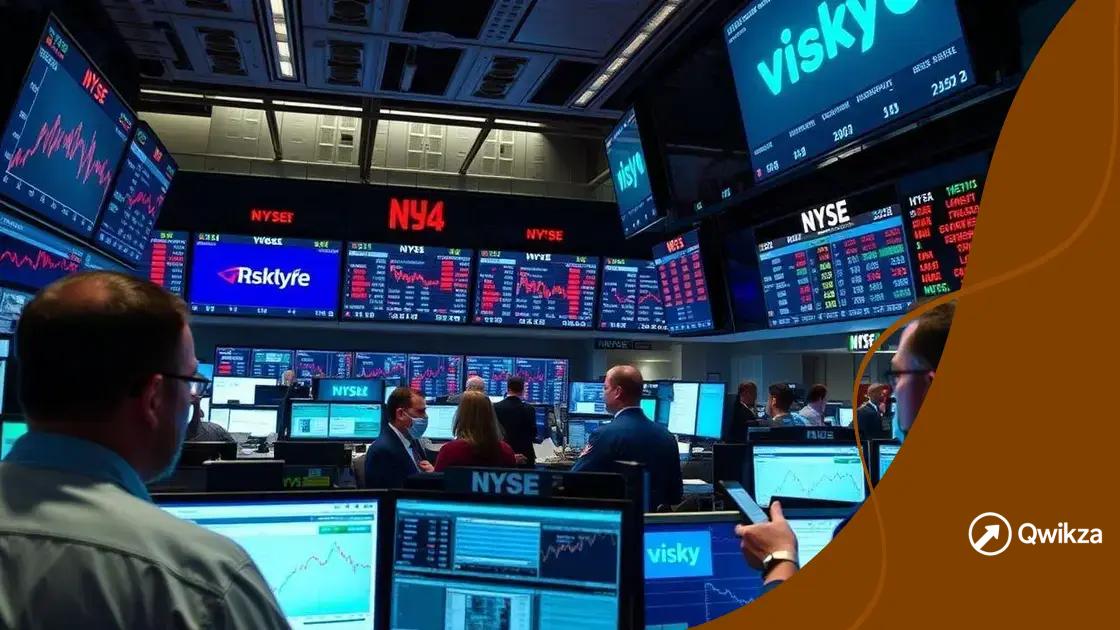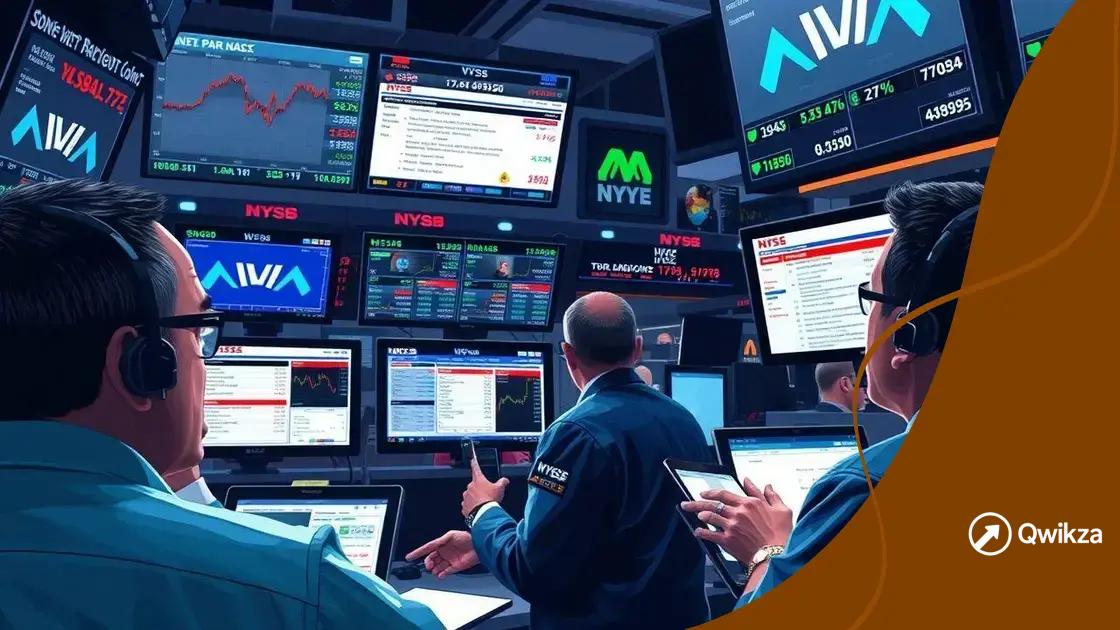Economic indicators and market reactions explained

Economic indicators are critical statistics that provide insights into a country’s economic performance, influencing market reactions and helping investors make informed decisions about buying or selling assets.
Economic indicators and market reactions play a crucial role in shaping financial landscapes. Have you ever wondered how these indicators influence your investment choices? In this article, we dive into their interconnectedness and what it means for you.
Understanding economic indicators
Understanding economic indicators is essential for making informed financial decisions. These metrics provide insight into the health of an economy and can influence market behavior. By analyzing these indicators, investors can better predict future trends and adjust their strategies accordingly.
What are Economic Indicators?
Economic indicators are statistics that reflect the overall performance of an economy. They can be classified into three main categories: leading, lagging, and coincident indicators. Each type serves a different purpose in economic analysis.
- Leading indicators: These predict future economic activity. Examples include stock market performance and new housing permits.
- Lagging indicators: These follow an event and confirm trends. The unemployment rate and corporate profits are examples.
- Coincident indicators: These occur simultaneously with the economy. Examples include GDP and retail sales.
Investors closely watch these indicators to gauge the economic environment. The relationship between economic indicators and market reactions is crucial. For instance, a rise in the unemployment rate might cause investors to sell stocks, fearing a recession. Conversely, a boost in manufacturing output could lead to increased confidence in the market.
Why Economic Indicators Matter
Understanding these signals helps in developing a successful investing strategy. Knowledge of economic conditions can enhance decision-making processes. For example, tracking inflation rates can allow investors to make timely adjustments in their portfolios. Additionally, by analyzing trends related to economic indicators, one can anticipate changes in market sentiment.
Ultimately, the connection between economic indicators and market reactions forms the basis of informed investment choices. Observing how these indicators change over time helps investors stay ahead in a competitive marketplace.
Types of economic indicators
When it comes to understanding the economy, knowing the types of economic indicators is vital. These indicators serve as tools to help analysts and investors gauge economic performance. Each type of indicator provides unique insights, influencing decision-making in investment and policy.
Leading Indicators
Leading indicators predict future economic activity, offering foresight into potential changes. Some common leading indicators include:
- Stock market performance: A rising stock market often suggests economic growth.
- New housing permits: Increased permits indicate future construction activity.
- Consumer confidence index: Higher confidence can lead to increased spending.
These indicators are crucial for anticipating trends and enabling proactive strategies.
Lagging Indicators
Lagging indicators confirm patterns after they have already occurred. They are useful for understanding the effectiveness of past policies. Key lagging indicators include:
- Unemployment rate: A rising rate often follows economic downturns.
- Gross Domestic Product (GDP): It reflects the overall economic activity and performance.
- Corporate profits: Increased profits usually follow periods of growth.
Monitoring these indicators helps assess how well an economy has performed in the past.
Coincident Indicators
Coincident indicators occur simultaneously with the economic cycle. They provide a real-time view of economic conditions. Examples include:
- Retail sales: Directly reflects consumer spending.
- Industrial production: Indicates the level of manufacturing activity.
- Personal income: Shows the overall financial health of consumers.
These indicators are essential for understanding current economic conditions and investor sentiment.
In summary, each type of economic indicator plays a vital role. Whether predicting future conditions or confirming past trends, understanding their differences helps investors navigate the complex economic landscape.
How market reactions occur

Understanding how market reactions occur is crucial for anyone interested in investing. Market reactions are influenced by various factors, and they reflect how investors respond to economic changes and information. These reactions can lead to significant fluctuations in asset prices, impacting overall market stability.
Triggers for Market Reactions
Several events can act as triggers for market reactions. These include economic reports, geopolitical events, and corporate earnings announcements. For example, positive employment data might lead to a surge in stock prices, while negative news about a company’s earnings could cause a sharp decline.
- Economic reports: Information on inflation rates, unemployment, and GDP can all influence investor confidence.
- Geopolitical events: Political instability or international conflicts may create uncertainty, prompting market sell-offs.
- Corporate earnings: Results that exceed expectations often lead to stock price increases, while poor earnings can lead to declines.
These triggers can lead to immediate market reactions, as traders may buy or sell assets based on their interpretations of the news.
The Role of Investor Psychology
Investor psychology plays a vital role in how market reactions unfold. Emotions such as fear and greed can heavily influence decision-making. When positive news emerges, investors may rush to buy, hoping for higher returns. Conversely, negative news can trigger panic selling, leading to sharp downturns in stock prices.
As news spreads, the information is analyzed, and traders react, often causing rapid fluctuations in the market. This behavior reinforces the concept of market sentiment and its direct impact on asset prices.
In summary, the interplay between news, investor psychology, and economic indicators shapes the landscape of market reactions. Understanding these dynamics helps investors navigate the complexities of trading and can lead to more informed financial decisions.
The impact of indicators on trading
The impact of economic indicators on trading is significant. These indicators inform investors about the health of the economy. They help traders make decisions on when to buy or sell assets. Understanding this relationship can greatly enhance trading success.
How Indicators Affect Market Sentiment
Economic indicators directly influence market sentiment. For example, positive news such as an increase in GDP or lower unemployment rates can boost investor confidence. This often leads to an uptick in stock prices. Conversely, negative indicators like rising inflation or worsening trade balances can lead to market sell-offs as investors react to potential economic downturns.
- GDP growth: Indicates a thriving economy, prompting investments.
- Unemployment rates: Lower rates can lead to bullish market trends.
- Inflation rates: High inflation can cause fear, driving market declines.
Traders monitor these indicators closely to navigate the ups and downs of the market. Small shifts in indicators can lead to large swings in trading behavior.
Strategizing Based on Indicators
Smart traders utilize economic indicators to develop their trading strategies. By analyzing reports and forecasts, they can identify trends and adjust their portfolios accordingly. For instance, if new housing starts are rising, it may signal a strong future for construction stocks. This knowledge can prompt traders to buy shares in that industry.
Furthermore, implementing technical analysis alongside economic indicators allows traders to pinpoint ideal entry and exit points. This dual approach enhances decision-making and maximizes potential profits.
As such, the awareness and understanding of economic indicators play an essential role in shaping trading decisions. Investors who leverage this information can better anticipate market reactions and respond proactively.
Looking ahead: future trends in economics
Looking ahead at future trends in economics is essential for investors and policymakers alike. As we navigate a rapidly changing world, several key trends are emerging that could shape economic landscapes. Understanding these trends can aid in making informed decisions and adapting strategies to succeed.
Technological Advancements
One major trend is the impact of technological advancements on the economy. Innovations in AI, automation, and big data are transforming industries. Businesses are increasingly relying on technology to improve efficiency and reduce costs. This technological shift can lead to job displacement but also creates new opportunities in emerging sectors.
- AI Integration: Companies are using AI to analyze market data, improve customer experiences, and streamline operations.
- Remote Work: The rise of remote work has changed how companies operate and hire talent.
- Green Technology: A focus on sustainable practices is driving growth in eco-friendly technologies.
These advancements promise to redefine economic activities and create new markets.
Globalization Trends
Globalization continues to evolve, shaping economic relationships across borders. The interconnectedness of economies means that events in one country can have ripple effects worldwide. Trade agreements, tariffs, and geopolitical tensions can significantly influence market dynamics.
As countries navigate these changes, businesses must adapt strategies to remain competitive. For instance, companies may diversify supply chains to mitigate risks associated with global disruptions.
Furthermore, emerging markets are gaining prominence, offering new opportunities for investment. Understanding local economies and consumer behavior in these regions will be crucial for success.
In conclusion, anticipating future trends in economics requires adaptation and foresight. By embracing technology and understanding the implications of globalization, businesses and investors can position themselves for success in an ever-changing economic environment.
FAQ – Frequently Asked Questions about Economic Indicators and Market Reactions
What are economic indicators?
Economic indicators are statistics that provide insight into the economic performance of a country, influencing investment and market behavior.
How do economic indicators affect market reactions?
Market reactions are often triggered by changes in economic indicators, leading investors to buy or sell based on their implications for future economic conditions.
Why is understanding technological advancements important in economics?
Technological advancements can significantly impact productivity and market trends, enabling businesses to adapt and thrive in a competitive environment.
What role does globalization play in economic trends?
Globalization connects economies worldwide, meaning that economic events in one region can influence markets in others, making it crucial for investors to monitor global developments.
